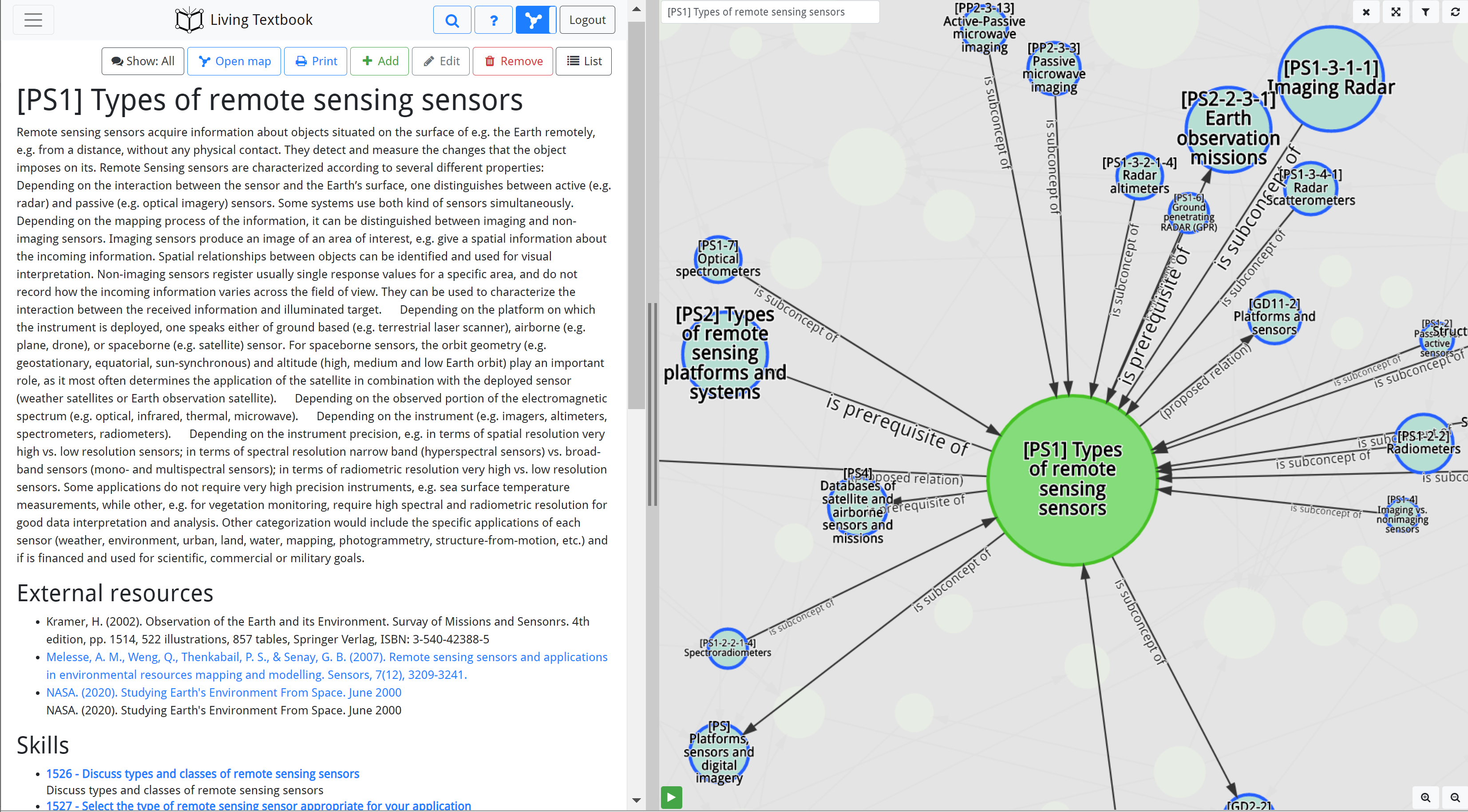Living Textbook
Collaborative creation and viewing of the EO4GEO Body of Knowledge


The Living Textbook (LTB) is used as the tool to create and maintain the EO4GEO Body of Knowledge (BoK). It allows users to create, edit and find concepts in the BoK.
The Living Textbook uses a concept map as a starting point and visualizes concepts and their relationships in one view, providing a convenient way to find connecting concepts and their descriptions. It provides an under-the-hood view of the BoK, also used by the contributing experts to develop and keep an overview of the BoK content.
In general, the Living Textbook is a tool that can be used to create a conceptual visualisation of a knowledge domain and share it amongst educators, researchers and anyone who would like to understand that domain. In some way it works as an advanced way of making a collaborative mind map. We call this a Body of Knowledge.
In the case of the EO4GEO project, we are visualising the domain of Geographic Information Science and Earth Observation. The tool is built in such a way that web applications can reuse the information via web interfaces. In this way, web application developers can create their own application on top of this information. EO4GEO uses the concepts, exported by the Living Textbook in its other tools such as the Curriculum Design Tool (CDT), the Occupational Profile Tool (OPT) and the Job Offer Tool (JOT).
To register or not to register? The EO4GEO Body of Knowledge is publicly available for viewing with the Living Textbook. For editing, registered experts get access to the Living Textbook and can contribute to one or more concepts, by adding or editing concept descriptions, external resources or adding skills that are relevant to that concept. You can register through the EO4GEO form, which is accessible on the EO4GEO website under Call for Experts.
Target audiences: Academia, training providers. The potential users of this tool are educators and researchers who can both produce and consume the content of any Body of Knowledge. The benefit of this tool is that it provides a web-based environment for a group of experts to discuss and agree on definitions, cross-references, the demarcation of the domain, etc. and that the consumers of the content always see the latest representation of the created content.
Examples of use:
- A teacher uses the Body of Knowledge to explain one or more of its concepts to students in a course.
- An expert in Earth Observation contributes the essentials of a new technology to the concepts in the Body of Knowledge.
- A web developer wants to create an application that allows users to view the content of the Body of Knowledge in a specific way or context.
Interested?
The Living Textbook is developed by the University of Twente, Faculty of Geo-Information Science and Earth Observation (ITC) For more information, CONTACT US.

EO4GEO LTB user guide
Manual for viewing the public EO4GEO BoK with the Living Textbook (LTB).
EO4GEO LTB video
Introduction video on the Living Textbook and the EO4GEO BoK. See the video in YouTube.
Accesss the application
Subscribe to our newsletter
Keep yourself updated, receive SPACE4GEO Alliance news and info on new opportunities.
Join the SPACE4GEO Alliance
Be part of the SPACE4GEO Alliance and let’s discuss and work together on the supply and demand of skills in the EO/GIS sector. Stakeholders in the EO, GIS and Skills sectors are more than welcome!
Join a Network pooling together expertise from academia, VET providers, company, public institutions, research centres and sectoral associations with the common goal of fostering skills development in the space and geoinformation downstream sector.
